Intel Core i7-10700 vs Core i7-10700K Review: Is 65W Comet Lake an Option?
by Dr. Ian Cutress on January 21, 2021 10:30 AM EST- Posted in
- CPUs
- Intel
- Core i7
- Z490
- 10th Gen Core
- Comet Lake
- i7-10700K
- i7-10700
CPU Tests: Encoding
One of the interesting elements on modern processors is encoding performance. This covers two main areas: encryption/decryption for secure data transfer, and video transcoding from one video format to another.
In the encrypt/decrypt scenario, how data is transferred and by what mechanism is pertinent to on-the-fly encryption of sensitive data - a process by which more modern devices are leaning to for software security.
Video transcoding as a tool to adjust the quality, file size and resolution of a video file has boomed in recent years, such as providing the optimum video for devices before consumption, or for game streamers who are wanting to upload the output from their video camera in real-time. As we move into live 3D video, this task will only get more strenuous, and it turns out that the performance of certain algorithms is a function of the input/output of the content.
HandBrake 1.32: Link
Video transcoding (both encode and decode) is a hot topic in performance metrics as more and more content is being created. First consideration is the standard in which the video is encoded, which can be lossless or lossy, trade performance for file-size, trade quality for file-size, or all of the above can increase encoding rates to help accelerate decoding rates. Alongside Google's favorite codecs, VP9 and AV1, there are others that are prominent: H264, the older codec, is practically everywhere and is designed to be optimized for 1080p video, and HEVC (or H.265) that is aimed to provide the same quality as H264 but at a lower file-size (or better quality for the same size). HEVC is important as 4K is streamed over the air, meaning less bits need to be transferred for the same quality content. There are other codecs coming to market designed for specific use cases all the time.
Handbrake is a favored tool for transcoding, with the later versions using copious amounts of newer APIs to take advantage of co-processors, like GPUs. It is available on Windows via an interface or can be accessed through the command-line, with the latter making our testing easier, with a redirection operator for the console output.
We take the compiled version of this 16-minute YouTube video about Russian CPUs at 1080p30 h264 and convert into three different files: (1) 480p30 ‘Discord’, (2) 720p30 ‘YouTube’, and (3) 4K60 HEVC.
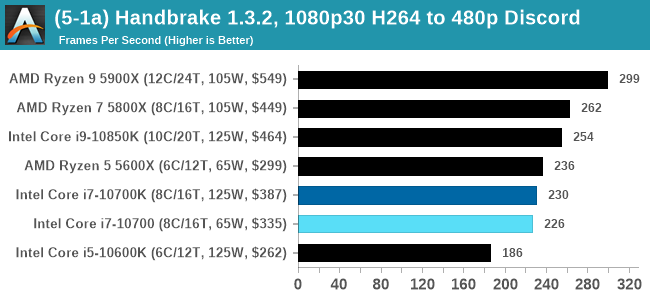

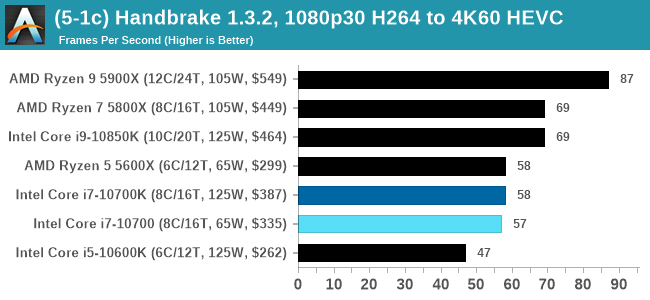
7-Zip 1900: Link
The first compression benchmark tool we use is the open-source 7-zip, which typically offers good scaling across multiple cores. 7-zip is the compression tool most cited by readers as one they would rather see benchmarks on, and the program includes a built-in benchmark tool for both compression and decompression.
The tool can either be run from inside the software or through the command line. We take the latter route as it is easier to automate, obtain results, and put through our process. The command line flags available offer an option for repeated runs, and the output provides the average automatically through the console. We direct this output into a text file and regex the required values for compression, decompression, and a combined score.
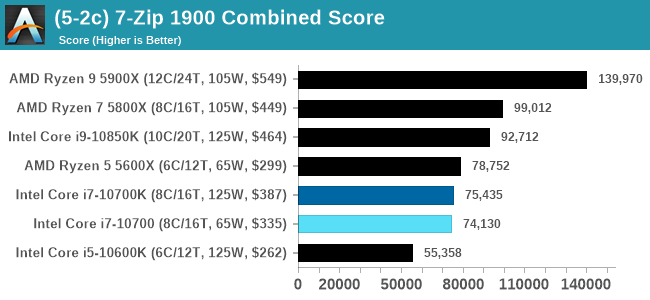
AES Encoding
Algorithms using AES coding have spread far and wide as a ubiquitous tool for encryption. Again, this is another CPU limited test, and modern CPUs have special AES pathways to accelerate their performance. We often see scaling in both frequency and cores with this benchmark. We use the latest version of TrueCrypt and run its benchmark mode over 1GB of in-DRAM data. Results shown are the GB/s average of encryption and decryption.
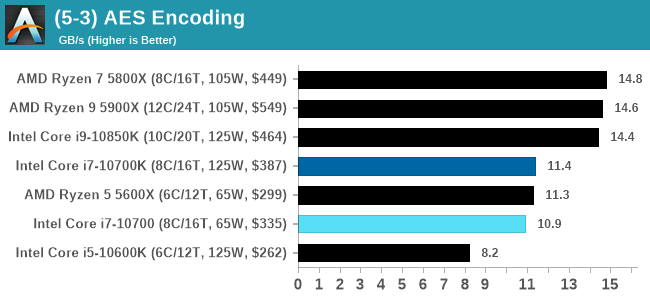
WinRAR 5.90: Link
For the 2020 test suite, we move to the latest version of WinRAR in our compression test. WinRAR in some quarters is more user friendly that 7-Zip, hence its inclusion. Rather than use a benchmark mode as we did with 7-Zip, here we take a set of files representative of a generic stack
- 33 video files , each 30 seconds, in 1.37 GB,
- 2834 smaller website files in 370 folders in 150 MB,
- 100 Beat Saber music tracks and input files, for 451 MB
This is a mixture of compressible and incompressible formats. The results shown are the time taken to encode the file. Due to DRAM caching, we run the test for 20 minutes times and take the average of the last five runs when the benchmark is in a steady state.
For automation, we use AHK’s internal timing tools from initiating the workload until the window closes signifying the end. This means the results are contained within AHK, with an average of the last 5 results being easy enough to calculate.
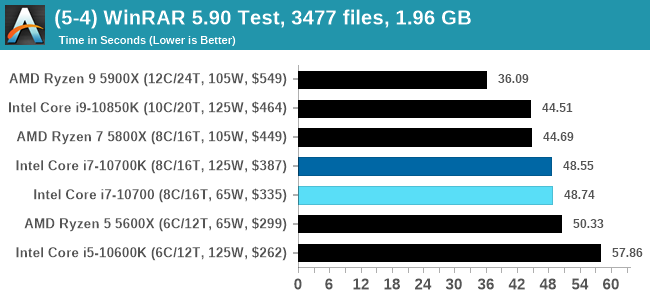


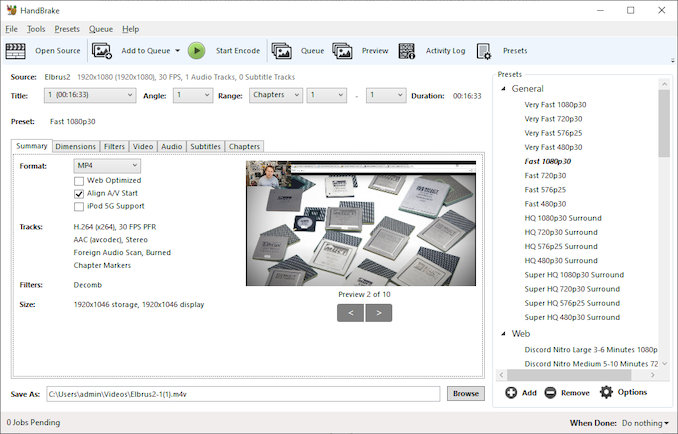
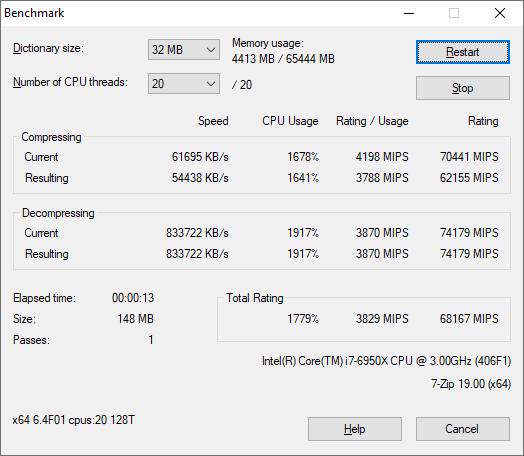









210 Comments
View All Comments
Spunjji - Wednesday, January 27, 2021 - link
The review didn't say it is a bad CPU.HarkPtooie - Tuesday, February 2, 2021 - link
Gigabyte B460M DS3HPegged at 100% CPU utilization on 8 cores (HT disabled) the wall meter says 149-163 W, CoreTemp says I use about 70 W core and 8 W uncore. CPU multiplier bounces between 43-47x, though mainly resting at 46x. Temps are 65-66°C using a humble CoolerMaster TX3 Evo.
Just upped the PL1 to 250 W in BIOS. It made no discernible difference, so I suppose it doesn't work on B460 chipsets.
Everett F Sargent - Tuesday, February 2, 2021 - link
Enable HT. If not then why not? The battery of tests conducted here and everywhere else have HT enabled. So far, you are still at the apples != oranges stage. It is now time for you to step up or ... :/Please post results with HT enabled.
Everett F Sargent - Tuesday, February 2, 2021 - link
Oh and the benchmark application that you are using (e. g. Prime95 or whatever) if you do not mind. Please. TIAHarkPtooie - Wednesday, February 3, 2021 - link
So: I set all the PL limits to max (4090 W) and reran. 173 W. Up 10-15 W from default.Then I enabled HT and reran. 213 W. +40 W compared to non-HT.
So I turned off the PL tweaking and reran, with HT on. 204 W initially, then after a while it went down to ca 140 W and the multipliers reduced to about 37x.
Kind of surprised that HT made such a difference, I was under the impression that HT "cores", being a small backpack aside the "real" core, added a tiny percent of transistors overall. I usually disable HT because the software I run don't benefit from them and actually loses performance with it.
So: mystery solved and I stand corrected.
Intel is not lying when they call this a 65 W CPU. They are however obscuring the fact that it does so with REDUCED PERFORMANCE. Its default behavior is to only run at 100% for half a minute.
When allowed by BIOS tweaks, it will double the power draw but run at 100% all the time. This is overclocking in the sense that default settings are overridden - but it is not in the sense that the peak speed is not actually driven above its intended levels. Just maintained at higher power draw.
Aight. I'm back to non-HT and free power. 173W is not that much.
Just did a compare of performance during my simulations, and they were more or less identical to the default settings.
Qasar - Thursday, February 4, 2021 - link
it is possible that the Gigabyte B460M DS3H that you are using ( as per a previous post ) could be holding the cpu back as far as overclocking, power usage and such goes. as the B460m doesnt support overclocking by intel, but asus, asrock and msi seems to have found a way to enable overclocking:https://www.techpowerup.com/266489/asrock-enables-...
https://videocardz.com/newz/asus-asrock-and-msi-br...
at the same time, though, what asus, asrock and msi have done, isnt really overclocking, but more of allowing the cpu to use its turbo states longer, then what intel allows
both of those links, could explain, at least partly, HarkPtooie, why you are getting the results you have.
Everett F Sargent - Thursday, February 4, 2021 - link
Yes, I found those links also. Conspicuously absent from all those reports was Gigabyte. But ...https://www.gigabyte.com/us/Motherboard/Intel-H470...
There you will find ...
B460M DS3H (rev. 1.0)
B460M DS3H AC (rev. 1.x)
B460M DS3H V2 (rev. 1.0)
(ranked oldest to newest afaik)
From the manual for the B460M DS3H (rev. 1.0) (page 25) ...
https://download.gigabyte.com/FileList/Manual/mb_m...
https://download.gigabyte.com/FileList/Manual/mb_m...
https://download.gigabyte.com/FileList/Manual/mb_m...
"Turbo Power Limits
Allows you to set a power limit for CPU Turbo mode. When the CPU power consumption exceeds the specified power limit, the CPU will automatically reduce the core frequency in order to reduce the power. Auto sets the power limit according to the CPU specifications. (Default: Auto)
Package Power Limit TDP (Watts) / Package Power Limit Time
Allows you to set the power limit for CPU Turbo mode and how long it takes to operate at the specified power limit. If the specified value is exceeded, the CPU will automatically reduce the core frequency in order to reduce the power. Auto sets the power limit according to the CPU specifications. This item is configurable only when Turbo Power Limits is set to Enabled. (Default: Auto)
DRAM Power Limit (Watts) / DRAM Power Limit Time
Allows you to set the power limit for memory Turbo mode and how long it takes to operate at the specified power limit. Auto lets the BIOS automatically configure this setting. This item is configurable only when Turbo Power Limits is set to Enabled. (Default: Auto)"
That same language can be found for all three MB manuals. So. it would appear that pl1, pl2 and tau are adjustable as HarkPtooie has suggested (but to be sure the latest bios version should be installed imho).
The only question I have is, why did Gigabyte apparently update the B460M DS3H (rev. 1.0) to the B460M DS3H V2 (rev. 1.0) (maybe they are different in some hardware way that I have failed to notice).
The stress test should be the one that produces the highest temperatures together with the best cooling solution possible for these non-K parts. It sounds a bit circular but then these are non-K parts where we constrain the control knobs to just pl1, pl2 and tau.
Spunjji - Monday, January 25, 2021 - link
"If you are going to make wild speculations whose veracity anyone can check, you might want to go over your material a bit better."The irony of ending your FUD with this... it's glorious!
HarkPtooie - Tuesday, January 26, 2021 - link
It would be ironic if I were wrong, but I sort of trust my eyes here. And my point was that anyone possessing an i7-10700 and a $20 wattmeter can easily check this too.Spunjji - Wednesday, January 27, 2021 - link
Good for you, but I don't trust your eyes - not when every objective review available on the internet contradicts you.